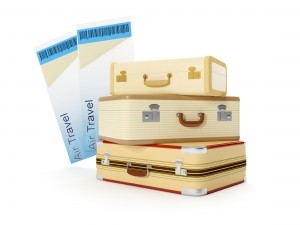5 Tips for Traveling with an Illness or Disability

Traveling with an illness or disability can be an ordeal. Now, I haven’t been on a vacation since I got Myasthenia Gravis (MG) back in 2008, which is why I “vacationize” my hospital visits. But I have traveled a few times to speak at conventions with my potpourri of illnesses. Tomorrow morning, I leave with my team for the State Championship. I coach high school debate and we’re going down state for a few days. I’m going through nausea with my new treatment. God, I hope I don’t vomit on the school bus. (All month long, I’ve been fighting nausea–I feel like vomiting but my body never does, which is a good thing, I think. Right?)
I carry a cane for the MG, but as many of you know, illnesses can be visible and invisible. The first time I had to think about traveling with illness was many years ago with bipolar disorder; because of bipolar, I travel with my lightbox. The lightbox regulates my circadian rhythms–helping me fight off depression and maintain a normal sleep-wake cycle (as normal as a person with multiple chronic pain diseases and bipolar can have). I use my light box everyday. Years ago, light boxes were HUGE and we actually had to carry the whole thing when I’d take trips to my cousin Erika’s swanky place in the city. That thing was as big as I am! Now, my box is small, has a nylon case, and can fit in my suitcase. Progress.
5 Tips for Traveling with an Illness or Disability
- Create a “Travel List.” I create a travel list and make two copies–one for the morning I leave and one for the day I come back. It’s hard to remember everything you need to carry if you’re in a hurry. On my travel list, I list everything I’m taking with me from the contents of my suitcase to “obvious” things like my cane. Then, I highlight all of the medical stuff. In fact, I put all of the medical stuff in a separate section at the top of the list. If I find myself waking up late the last day of my trip and in a hurry, I focus on everything highlighted in yellow first. I can forget my lipstick but not my medical card. Even though I wouldn’t have believed it when I was 19, I can live without lipstick. By contrast, I can’t live without my medications.
- Bring snacks and water. One of my aunts has diabetes, and it’s obvious why someone with diabetes needs to bring snacks and water. But the need for sustenance is applicable to patients with other diseases as well. Tomorrow, I’m packing healthy snacks and water because I can’t take meds for any of my illnesses without eating first.
- Call in advance for disability accommodations. When it’s possible, call in advance. For example, I called the hotel earlier this week asking for a shower stool or chair. They responded by telling me they’re giving me a room with a disability-accessible shower.
- Bring copies of medical information. Bring a list of your medications, copies of your doctors’ medical information, insurance information, and a list of your diseases (especially if you have more than one). I have loved ones who can’t remember all the diseases I have, and quite frankly, I can’t blame them. I have a spreadsheet with medications in one column and the corresponding disease (MG, bipolar, polycystic ovarian syndrome, psoriasis, asthma) in the second.
- Be honest with your travel companion(s). With fatigue or pain or other limitations posed by illness, it can be hard to keep up with our travel companions. Even if we shouldn’t feel guilty, sometimes we can feel like we’re letting people down. There were times in the past when I was in way too much pain to do things because of polycystic ovarian syndrome but I didn’t say anything because I was embarrassed (plus it was an invisible illness so I think that played into the shame). Visible or invisible, our family and friends can’t read our minds. If you can’t go sightseeing or rock climbing or whatever, be honest about it. Not everyone will “get it,” but people can’t understand when we don’t give them a chance.
Related: Click here to learn more about TSA-Pre-Check!

Your Turn?
What do you do when you travel? How do you manage your illness?Share your advice on Fashionably ill’s Facebook page here!
–Your Stylist, Jessica Gimeno





I find that at some point during longer flights I can start to experience shortness of breath and must use my asthma inhaler. I did some research and found articles from the World Health Organization and ABC News (Mar 24, 2008) explaining that as aircraft reach their cruising altitudes, they must reduce the in-cabin air pressure to be equal to altitudes between 6000 and 8000 feet. This is like being on a high mountain-top and results in an oxygen level decrease of about 4.4%. This does not affect most people. But if you have asthma, COPD, or other medical problems, this can make the trip extremely uncomfortable.
The airplane’s lightweight design could not handle being pressurized to the air pressure that we normally live in, closer to sea level. So, prepare yourself for those flights over about 3 hours.